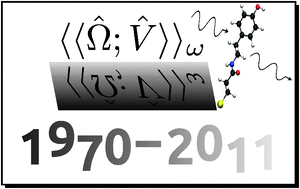A perspective on nonresonant and resonant electronic response theory for time-dependent molecular properties
Abstract
The development of electronic response theory in quantum chemistry has been reviewed, starting from the early 1970's and reaching the current state-of-the-art. The general theory has been applied to the calculation of a large number of spectroscopic parameters over the years, and it has been implemented for the majority of standard electronic structure methods. Two formulations of response theory, the Ehrenfest expectation value and the quasi-energy derivative formulation, have turned into leading alternatives for the derivation of computationally tractable expressions of response functions, and they are here reviewed with an attempt to, as far as possible, leave out technical details. A set of four steps are identified as common in derivations of response functions, and the two formulations are compared along this series of steps. Particular emphasis is given to the situation when the oscillation of the weak external electromagnetic field is in resonance with a transition frequency of the system. The formation of physically sound response functions in resonance regions of the spectrum is discussed in light of the causality condition and the Kramers–Kronig relations, and it is achieved in wave function theory by means of the introduction of relaxation parameters in a manner that mimics what one sees in density

- This article is part of the themed collection: Aromaticity, electron delocalisation, and related molecular properties

 Please wait while we load your content...
Please wait while we load your content...